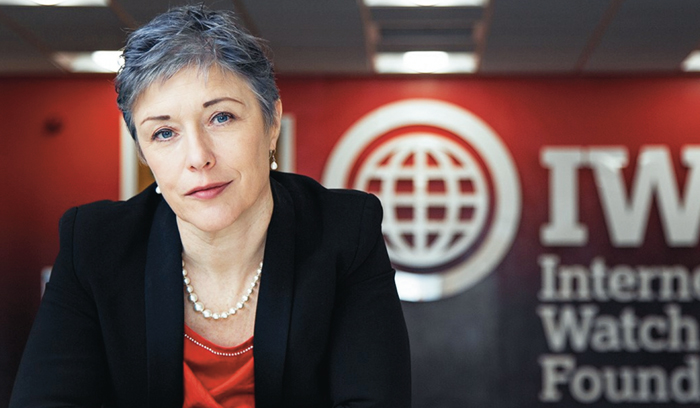Taskforce set up to stop 'most severe' child sexual abuse images and videos being shared online
A new taskforce has been set up that will take ‘digital fingerprints’ of millions of child abuse images so that they can be identified and removed by companies and organisations around the world.
The new team of “highly trained analysts’ has been launched by the Internet Watch Foundation (IWF) following record numbers of reports of illegal online content.
The taskforce will assess and grade millions of the most severe images and videos of child rape and sexual torture.
IWF chief executive Susie Hargreaves OBE said it will be “a major step forward for internet safety”.
Analysts will view, hash (create a digital fingerprint), and classify two million Category A and B images from the Government’s Child Abuse Image Database (CAID).
They will then distribute the hashes globally to technology companies, allowing them to be blocked or removed should anyone attempt to share them anywhere in the world.
Category A images involve penetrative sexual activity and sexual activity with an animal or sadism, while Category B images involve non-penetrative sexual activity.
The IWF – the UK charity responsible for finding and removing images and videos of child sexual abuse from the internet – is the only non-law enforcement body with access to CAID.
It says the work will boost the UK’s contribution to global efforts to stop the distribution of child sexual abuse images on the internet and help to keep the internet a safer place for all.
Hashing an image or video is a process which produces a unique code like a ‘digital fingerprint’ so that it can be recognised and dealt with quickly by the IWF or its partners in the future.
This will enable technology companies to take swift action to prevent the spread of abusive material, giving peace of mind to victims who often live with the knowledge footage of their abuse could be being shared by criminals around the world, said the IWF.
The new taskforce is being funded with a grant from international child protection organisation Thorn.
Ms Hargreaves said: “We’ve created this world-leading taskforce of highly trained analysts to help boost the global efforts to stop the distribution of child sexual abuse imagery online.
“Not only will this absolutely vital work help to create a safer internet for us all, but it will help those victims whose sexual abuse imagery is shared time and time again, preventing their continued re-victimisation and exploitation.
“Thanks to the funding provided by Thorn, and the access to the UK Government’s CAID, this will be a major step forward for internet safety.”

In 2020, the IWF dealt with a record number of reports of online child sexual abuse. Analysts processed 299,600 reports, which include tip-offs from members of the public. This is up from 260,400 reports in 2019 – an increase of 15 per cent.
Of these reports, 153,350 were confirmed as containing images and/or videos of children being sexually abused. This compares to 132,700 in 2019 – an increase of 16 per cent. Every report contains between one and thousands of child sexual abuse images and videos. This equates to millions of images and videos, said the IWF.
New figures just released also show an “appalling rise” in children being tricked into sexually abusing themselves on camera
The IWF said ‘self-generated’ content of child sexual abuse has more than doubled in the first few months of this year.
Self-generated content can include child sexual abuse content, which has been created using webcams, very often in the child’s own room, and then shared online.
In some cases, children are groomed, deceived or extorted into producing and sharing a sexual image or video of themselves. Some of these videos contain Category A material.
The new data shows that from January to April 2021, just over 38,000 reports the IWF actioned included ‘self-generated’ content. This is up from 17,500 reports in the same period last year – an increase of 117 per cent.
Ms Hargreaves said: “We are appalled by these numbers. We know the abuse these children suffer is real, and there should be no doubt that this has become a grave and widespread threat.
“Predators are extremely devious, and have worked out that they do not need to physically contact a child to inflict long-lasting harm and abuse on them. They can now, in just a few clicks, reach children at home through their devices and speak to them in their own bedrooms.”
Safeguarding Minister Victoria Atkins said: “This government is determined to ensure that we are doing everything in our power to prevent child sexual abuse online and the innovative use of technology is central to this.
“I am pleased that CAID data is helping the IWF to carry out this valuable work towards reducing access to child sexual abuse material online and thereby preventing the re-victimisation of children.
“Our Tackling Child Sexual Abuse Strategy highlights that our investment in CAID will allow greater sharing of data to help safeguard more victims and bring more offenders to justice.”
Julie Cordua, chief executive officer of Thorn, added: “IWF’s work to eliminate child sexual abuse images from the internet and end the cycle of re-victimisation is critical and tremendously difficult.
“We are grateful for their continued commitment to this work.”
Last month, the IWF launched a hard-hitting new campaign warning teenage girls and their parents about the dangers of being groomed online by sexual predators.
The campaign, backed by the Home Office and Microsoft, has two main themes: the ‘Gurls out loud’ campaign aims to prevent teenage girls from falling victim to grooming techniques, while the ‘Home Truths’ campaign warns parents about how predators are seeking to groom and coerce children online.


